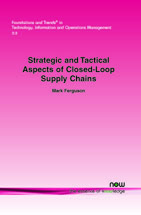Strategic and Tactical Aspects of Closed-Loop Supply Chains
By Mark Ferguson, College of Management, Georgia Institute of Technology, USA, mark.ferguson@mgt.gatech.edu
Abstract
Today's common business practice of extracting non-renewable raw materials from the earth, processing them, turning them into products, selling the products to customers, and then having the customers dispose of the products in a landfill or through incineration is not sustainable. Eventually, the basic raw materials that are used to build most of the products our economy is based on will run out, or become prohibitively expensive to extract more of. Cognizant of this fact, many firms are taking a closer look at their supply chain practices and exploring ways to reduce (or at least prolong the timing of) the amount of their product that ends up in landfills. They do so by finding profitable ways to recover their used products for remanufacturing, refurbishing, or recycling. The study of these efforts has been termed Closed-Loop Supply Chains.
In this monograph, we review some of the recent research in this field, with a particular focus on the strategic and tactical issues. Representative models from each area are presented along with their key managerial insights, providing the reader with both a high-level overview and an in-depth look at the common assumptions and modeling frameworks that are used. Where appropriate, suggestions for needed research are pointed out. The monograph is not intended to be a comprehensive review of the field, but rather an introduction to some of the more recent developments.
Strategic and Tactical Aspects of Closed-Loop Supply Chains
Today's common business practice of extracting non-renewable raw materials from the earth, processing them, turning them into products, selling the products to customers, and then having the customers dispose of the products in a landfill or through incineration is not sustainable. Eventually, the basic raw materials that are used to build most of the products our economy is based on will run out, or become prohibitively expensive to extract. Cognizant of this fact, many firms are taking a closer look at their supply chain practices and exploring ways to reduce the amount of their product that ends up in landfills. They do so by finding profitable ways to recover their used products for remanufacturing, refurbishing, or recycling. The study of these efforts has been termed Closed-Loop Supply Chains. Strategic and Tactical Aspects of Closed-Loop Supply Chains reviews the recent research in this field with a particular focus on the strategic and tactical issues. Representative models from each area are presented along with their key managerial insights, providing the reader with both a high level overview and an in-depth look at the common assumptions and modeling frameworks that are used. Where appropriate, suggestions for needed research are pointed out.
